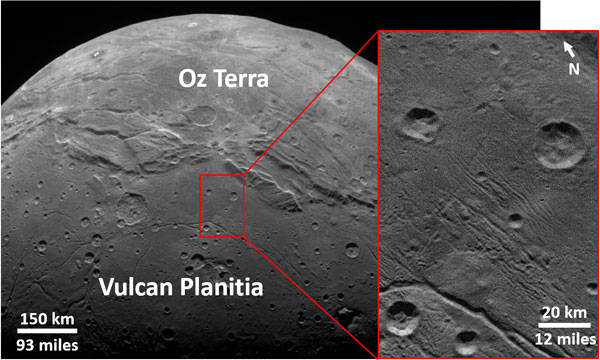RSR's List of Solar System Formation Problems 2
This is the show from Friday July 24th, 2015
Summary:
* Conclusion of this RSR List Show: Hear part 1 www.atrsr.org/solar-system.

* March 2015 IAU Image Typical of Pluto Expectations: (Below, see our list of solar system formation problems.) Just a few months ago, the International Astronomical Union used an image of Pluto (right) that represents the expectations of secular astronomers depicting a heavily cratered body grimy from sweeping up billions of years of space dust. Again though, the predictions of old-earth astronomy failed. Likewise, from its physics to its major predictions, the entire theory of solar system formation, the nebular hypothesis, has failed. Real Science Radio hosts Bob Enyart and Fred Williams back up to get the big picture by quoting NASA's exoplanet database manager Caltech astronomer Mike Brown who said: “Before we ever discovered any [planets outside the solar system] we thought we understood the formation of planetary systems pretty deeply… It was a really beautiful theory. And, clearly, thoroughly wrong." Exoplanets, with their masses, sizes, composition and orbital characteristics differ from what had been predicted for decades by the standard model of solar system formation, including with their retrograde orbits, highly inclined orbits and hot jupiters, effectively falsifying that model.

* July 2015 What Pluto Actually Looks Like: The actual photos of Pluto from NASA's New Horizons mission will help make it obvious to thousands more people that the nebular hypothesis theory of origins is not helpful in understanding our solar system (or any other solar system for that matter). On today's program, Bob and Fred air an audio clip from a a leading planetary scientist on the Passport to Pluto Science Channel update on NASA's mission acknowledging that even close to home, the predictions of mainstream (secular) astronomy mostly fail, and that's for planets nearest to home, in our very own solar system system. Taken together, the impressive scientific discoveries that completely falsify the nebular hypothesis of solar system formation include these:
- exoplanets contradicting the predictions of the theory
- that our Sun is missing nearly 100% of its predicted spin
- that our Sun's rotation is seven degrees off the ecliptic
- the missing predicted uniform distribution pattern of solar system isotopes
- the missing expected uniform distribution of Earth's radioactivity
- the contrary-to-expectations fine tuning of the solar system
- the many contrary-to-expectations transient events in the solar system
- that proponents try to prop up the theory by claiming ubiquitous planetary catastrophism
- planetary and star formation problems have seemingly intractable physics problems (consider the Philae landing)
- contrary to an Oort or Kuiper origin, comets contain earth-like minerals and rounded boulders
- short-period comets still exist even though they have lifespans of only thousands of years
- the 1,346 trans-Neptunian objects with known orbits reach perihelion at the ecliptic
- that Mercury has greater density than can be accounted for by evolutionary accretion
- that Uranus rotates perpendicularly and Venus rotates backwards.
So the Corporation for Public Broadcasting, the BBC, Nova, Bill Nye, Lawrence Krauss, etc., wrongly built public confidence in the secular origins nebular hypothesis story. The longstanding claims of solar system formation were invented ad hoc to account for the particulars of our own solar system. Now that thousands of exoplanets are being discovered, the story telling will simply become, as with epicycles and levels of Darwinian selection, shall we say, more complex.
* Socks Blown Off: From RSR's List of Shocked Evolutionists, close-up photos show the youthful appearance of Pluto as do the images of its largest moon: "We originally thought Charon would be an ancient terrain covered in craters," said New Horizons team member Cathy Olkin. "So when we saw the pictures this morning, it just blew our socks off."

* Help Us Reach a Small YouTube Milestone: RSR's newly attended to Bob Enyart YouTube channel is about to hit 75,000 views. Please click to check out a video, and we should hit that goal by Saturday, July 18th!
* Get a Real Astronomy Resource: Get the Spike Psarris DVD What You Aren't Being Told About Astronomy and Vol. II, Our Created Stars and Galaxies! These are hands down the best astronomy videos ever made! You'll agree, or your money back! Also, purchasing them from us here at RSR will help us keep our radio show on the air reaching more and more people! And have you browsed through our Science Department in our KGOV Store? (That's what we call it.) Check out also Bob Enyart’s Age of the Earth Debate against a well-known geophysicist and a University of Colorado mathematician who are members of the Denver chapter of Reasons to Believe. And we ask you to consider getting a Bob Enyart Live monthly subscription, in audio or video, of one of our really fun and educational resources!
Finally, please consider helping us reach our vitally important July 2015 Telethon goal of $30,000! We're currently at $11,600, and you can help by clicking on the Store tab above, and then making a one-time or monthly donation, or signing up for a subscription or browsing our Science Department for some great science resources!
This is the show from Friday July 24th, 2015
Summary:
* Conclusion of this RSR List Show: Hear part 1 www.atrsr.org/solar-system.

* March 2015 IAU Image Typical of Pluto Expectations: (Below, see our list of solar system formation problems.) Just a few months ago, the International Astronomical Union used an image of Pluto (right) that represents the expectations of secular astronomers depicting a heavily cratered body grimy from sweeping up billions of years of space dust. Again though, the predictions of old-earth astronomy failed. Likewise, from its physics to its major predictions, the entire theory of solar system formation, the nebular hypothesis, has failed. Real Science Radio hosts Bob Enyart and Fred Williams back up to get the big picture by quoting NASA's exoplanet database manager Caltech astronomer Mike Brown who said: “Before we ever discovered any [planets outside the solar system] we thought we understood the formation of planetary systems pretty deeply… It was a really beautiful theory. And, clearly, thoroughly wrong." Exoplanets, with their masses, sizes, composition and orbital characteristics differ from what had been predicted for decades by the standard model of solar system formation, including with their retrograde orbits, highly inclined orbits and hot jupiters, effectively falsifying that model.

* July 2015 What Pluto Actually Looks Like: The actual photos of Pluto from NASA's New Horizons mission will help make it obvious to thousands more people that the nebular hypothesis theory of origins is not helpful in understanding our solar system (or any other solar system for that matter). On today's program, Bob and Fred air an audio clip from a a leading planetary scientist on the Passport to Pluto Science Channel update on NASA's mission acknowledging that even close to home, the predictions of mainstream (secular) astronomy mostly fail, and that's for planets nearest to home, in our very own solar system system. Taken together, the impressive scientific discoveries that completely falsify the nebular hypothesis of solar system formation include these:
- exoplanets contradicting the predictions of the theory
- that our Sun is missing nearly 100% of its predicted spin
- that our Sun's rotation is seven degrees off the ecliptic
- the missing predicted uniform distribution pattern of solar system isotopes
- the missing expected uniform distribution of Earth's radioactivity
- the contrary-to-expectations fine tuning of the solar system
- the many contrary-to-expectations transient events in the solar system
- that proponents try to prop up the theory by claiming ubiquitous planetary catastrophism
- planetary and star formation problems have seemingly intractable physics problems (consider the Philae landing)
- contrary to an Oort or Kuiper origin, comets contain earth-like minerals and rounded boulders
- short-period comets still exist even though they have lifespans of only thousands of years
- the 1,346 trans-Neptunian objects with known orbits reach perihelion at the ecliptic
- that Mercury has greater density than can be accounted for by evolutionary accretion
- that Uranus rotates perpendicularly and Venus rotates backwards.
So the Corporation for Public Broadcasting, the BBC, Nova, Bill Nye, Lawrence Krauss, etc., wrongly built public confidence in the secular origins nebular hypothesis story. The longstanding claims of solar system formation were invented ad hoc to account for the particulars of our own solar system. Now that thousands of exoplanets are being discovered, the story telling will simply become, as with epicycles and levels of Darwinian selection, shall we say, more complex.
* Socks Blown Off: From RSR's List of Shocked Evolutionists, close-up photos show the youthful appearance of Pluto as do the images of its largest moon: "We originally thought Charon would be an ancient terrain covered in craters," said New Horizons team member Cathy Olkin. "So when we saw the pictures this morning, it just blew our socks off."

* Help Us Reach a Small YouTube Milestone: RSR's newly attended to Bob Enyart YouTube channel is about to hit 75,000 views. Please click to check out a video, and we should hit that goal by Saturday, July 18th!
* Get a Real Astronomy Resource: Get the Spike Psarris DVD What You Aren't Being Told About Astronomy and Vol. II, Our Created Stars and Galaxies! These are hands down the best astronomy videos ever made! You'll agree, or your money back! Also, purchasing them from us here at RSR will help us keep our radio show on the air reaching more and more people! And have you browsed through our Science Department in our KGOV Store? (That's what we call it.) Check out also Bob Enyart’s Age of the Earth Debate against a well-known geophysicist and a University of Colorado mathematician who are members of the Denver chapter of Reasons to Believe. And we ask you to consider getting a Bob Enyart Live monthly subscription, in audio or video, of one of our really fun and educational resources!
Finally, please consider helping us reach our vitally important July 2015 Telethon goal of $30,000! We're currently at $11,600, and you can help by clicking on the Store tab above, and then making a one-time or monthly donation, or signing up for a subscription or browsing our Science Department for some great science resources!



